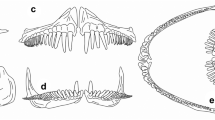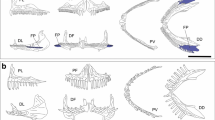Abstract
Two species of fiddler crab, Uca tetragonon(Herbst, 1790) and Uca vocans(Linnaeus, 1758), which belong to the subgenus Gelasimus, dwell on rocky shores and muddy–sandy tidal flats, respectively, in Phuket Is., Thailand. We investigated their feeding ecology in relation to the morphology of their feeding organs: minor food-handling chelipeds and maxillipeds. U. tetragononfed chiefly on rocks covered by filamentous green algae. U. vocansfed on the emerged sand and in shallow water along the shoreline and in pools. While feeding, both crabs made sand pellets beneath their mouthparts and discarded them, indicating that they divided the matter scooped up with their minor chelipeds into edible and inedible fractions by using the maxillipeds in the water passing through their buccal cavity. The morphology of maxillipeds hardly differed between the two species, which means that both species are flotation-feeders. The morphology of their minor chelipeds, however, differed: the tips of the dactyl and pollex were flat in U. tetragononand pointed in U. vocans.When the minor cheliped was closed, U. tetragononhad a hemispherical space in the distal one-fourth of the gape, which was closed by the framing keratin layers and a few setae of the dactyl and pollex. On the other hand, U. vocanshad an ellipsoidal space in the distal half of the gape. We consider these morphological characters to be adaptations to the different feeding substrates for retaining more food-laden sediment. We discuss the role of the setae on the minor chelipeds on the basis of the morphological differences between populations of U. tetragononin Phuket Is. and East Africa where the crab inhabits muddy–sandy tidal flats.
Similar content being viewed by others
References
Backwell, P. Y., P. D. O'hara & J. H. Christy, 1998. Prey availability and selective foraging in shore birds. Animal Behaviour 55: 1659-1667.
Crane, J., 1975. Fiddler Crabs of the World. Ocypodidae: Genus Uca. Princeton University Press, Princeton, New Jersey, pp. 1-736.
Croll, G. A. & J. B. McClintock, 2000. An evaluation of lekking behavior in the ddler crab Uca spp. Journal of Experimental Marine Biology and Ecology 254: 109-121.
Dye, A. H. & T. A. Lasiak, 1986. Microbenthos, meiobenthos and ddler crabs: trophic interactions in a tropical mangrove sediment. Marine Ecology Progress Series 32: 259-264.
Fielder, D. R. & M. B. Jones, 1978. Observations of feeding behaviour in two New Zealand mud crabs (Helice crassa and Macrophthalmus hirtipes). Mauri Ora 6: 41-46.
Frith, D. W., 1977. A preliminary list of macrofauna from a mangrove forest and adjacent biotopes at Surin Island, western peninsula Thailand. Phuket Marine Biological Center Research Bulletin 17: 1-14.
Frith, D. W. & C. B. Frith, 1977. Observations on ddler crabs (Ocypodidae: genus Uca) on Surin Island, western peninsula Thailand, with particular reference to Uca tetragonon (Herbst). Phuket Marine Biological Center Research Bulletin 18: 1-14.
Frith, D. W. & C. B. Frith, 1978. Notes on the ecology of ddler crab populations (Ocypodidae: genus Uca) on Phu-ket, Surin Nua and Yao Yai Island, western peninsula Thailand. Phuket Marine Biological Center Research Bulletin 25: 1-13.
Grant, B. R. & P. R. Grant, 2003. What Darwin's nches can teach us about the evolutionary origin and regulation of biodiversity. Bioscience 53: 965-975.
Icely, J. D. & D. A. Jones, 1978. Factors a. ecting the distri-bution of the genus Uca (Crustacea: Ocypodidae) on an east African shore. Estuarine, Coastal and Marine Science 6: 315-325.
Koga, T., P. R. Y. Backwell, M. D. Jennions & J. H. Christy, 1998. Elevated predation risk changes mating behaviour and courtship in a ddler crab. Proceedings of the Royal Society of London 265B: 1385-1390.
Levinton, J., C. Sturmbauer & J. Christy, 1996. Molecular data and biogeography: resolution of a controversy over evolu-tionary history of a pan tropical group of invertebrates. Journal of Experimental Marine Biology and Ecology 203: 117-131.
Macintosh, D. J., 1979. The Ecology and Energetics of Man-grove Fiddler Crabs (Uca spp.) on the West Coast of Malay Peninsula. Ph. D. Thesis, University of Malaya, Kuala Lumpur, Malaysia.
Martens, K. & I. Schon, 1999. Crustacean biodiversity in an-cient lakes: a review. Crustaceana 72: 899-910.
Matsumasa, M., S. Takeda, S. Poovachiranon & M. Murai, 1992. Distribution and shape of Dotilla myctiroides (Brachyura: Ocypodidae) burrow in the seagrass Enhalus acoroides zone. Benthos Research 43: 1-9.
Meziane, T., M. C. Sanabe & M. Tsuchiya, 2002. Role of d-dler crabs of a subtropical intertidal. at on the fate of sed-imentary fatty acids. Journal of Experimental Marine Biology and Ecology 270: 191-201.
Miller, D. C., 1961. The feeding mechanism of ddler crabs, with ecological considerations of feeding adaptations. Zoo-logica 46: 89-101.
Murai, M., S. Goshima & Y. Nakasone, 1982. Some behavioral characteristics related to food supply and soil texture of burrowing habitats observed on Uca vocans vocans and U. lactea perplexa. Marine Biology 66: 191-197.
Murai, M., S. Goshima & Y. Nakasone, 1983. Adaptive dro-ving behavior observed in the ddler crab Uca vocans vocans. Marine Biology 76: 159-164.
Nakasone, Y., 1982. Ecology of the ddler crab Uca (Thalass-uca) vocans vocans (Linnaeus) (Decapoda: Ocypodidae). I. Daily activity in warm and cold seasons. Research on Population Ecology 24: 97-109.
Ono, Y., 1965. On the ecological distribution of ocypoid crabs in the estuary. Memoirs of the Faculty of Science, Kyushu University, Series E (Biology) 4: 1-60.
Remsen, J. & R. Desalle, 1998. Character congruence of mul-tiple data partitions and the origin of the Hawaiian Droso-philidae. Molecular Phylogenetics and Evolution 9: 225-235.
Robertson, J. R. & S. Y. Newell, 1982a. Experimental studies of particle ingestion by the sand ddler crab Uca pugilator (Bosc). Journal of Experimental Marine Biology and Ecology 59: 1-21.
Robertson, J. R. & S. Y. Newell, 1982b. A study of particle ingestion by three ddler crab species foraging on sandy substratum. Journal of Experimental Marine Biology and Ecology 65: 11-17.
Rosenberg, M. S., 2001. The systematics and taxonomy of ddler crabs: a phytogeny of the genus Uca. Journal of Crustacean Biology 21: 839-869.
Rosenberg, M. S., 2002. Fiddler crab claw shape variation: a geometric morphometric analysis across the genus Uca (Crustacea: Brachyura: Ocypodidae). Biological Journal of the Linnean Society 75: 147-162.
Salmon, M. & N. Zucker, 1988. Interpreting differences in the reproductive behavior of ddler crabs (genus Uca). In Chelazzi G. & M. Vannini (eds), Behavioral Adaptation to Intertidal Life. Plenum Press, New York: i-ix, 1-524, 387-407.
Takeda, S. & M. Murai, 1993. Asymmetry in male ddler crabs is related to the basic pattern of claw-waving display. Biological Bulletin 184: 203-208.
Takeda, S. & M. Murai, 2003. Morphological and behavioural adaptations to the rocky substrate by the ddler crab Uca panamensis (Stimpson, 1859): preference for feeding sub-stratum and feeding mechanism. Journal of Experimental Marine Biology and Ecology 287: 179-191.
Takeda, S., M. Matsumasa, S. Kikuchi, S. Poovachiranon & M. Murai, 1996. Variation in the branchial formula of semi terrestrial crabs (Decapoda: Brachyura: Grapsidae and Ocypodidae) in relation to physiological adaptations to the environment. Journal of Crustacean Biology 16: 472-486.
Turner, G. F., 1999. Explosive speciation of African cichlid shes. In Magurran, A. E. & R. M. May (eds), Evolution of Biological Diversity. Oxford University Press, Oxford, U. K.: 113-139.
Wada, K., 1982. Substratum preference and feeding activity in Scopimera globosa De Haan and Ilyoplax pusillus (De Haan) (Crustacea: Ocypodidae). Benthos Research 23: 14-26 (Japanese with English Abstract).
Wada, K. & D. Wowor, 1989. Foraging on mangrove pneu-matophores by ocypodid crabs. Journal of Experimental Marine Biology and Ecology 134: 89-100.
Wolfrath, B., 1992. Field experiments on feeding of European ddler crab Uca tangeri. Marine Ecology Progress Series 90: 39-43.
Zimmer-Faust, R. K., 1987. Substrate selection and use by a deposit-feeding crab. Ecology 68: 955-970.
Author information
Authors and Affiliations
Rights and permissions
About this article
Cite this article
Takeda, S., Poovachiranon, S. & Murai, M. Adaptations for feeding on rock surfaces and sandy sediment by the fiddler crabs (Brachyura: Ocypodidae) Uca tetragonon(Herbst, 1790) and Uca vocans(Linnaeus, 1758). Hydrobiologia 528, 87–97 (2004). https://doi.org/10.1007/s10750-004-1874-2
Issue Date:
DOI: https://doi.org/10.1007/s10750-004-1874-2




